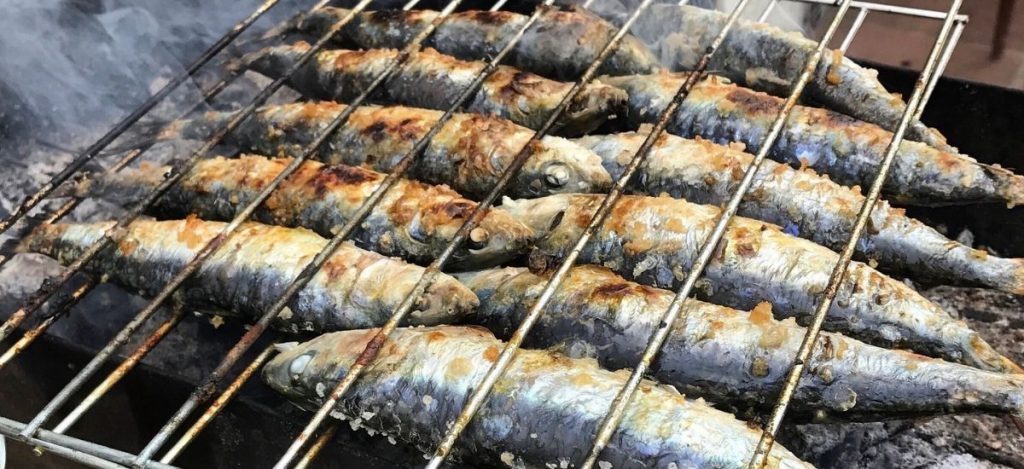If there is one thing that reminds me of my summers in Portugal, it’s the smell of sardines on the grill, whether it’s while walking through the streets there or even just grilling them in my own backyard here in the U.S. The smell of grilled sardines evokes the sweetest and dearest memories for me. It takes me back way back to being under the grapevine at my grandparents’ house in Portugal with family and friends enjoying a “sardinhada” (a complete grilled sardine feast with all the fixings). Besides it being a beloved traditional Portuguese meal, a sardinhada is extra special in that it is a time to gather with loved ones and truly one of the joys of summer. Sardines are also very popular at summer festivals, particularly at the Santo Antonio festivities in Lisbon.
Sardines rank right up there with Salt Cod as far as being one of the staples of Portuguese cuisine. However, contrary to cod, sardines are caught in Portuguese waters. Being from the coastal town of Figueira da Foz, whenever having sardines in Portugal, a family member goes directly to the “lota” (fish auction) to buy freshly caught sardines. However, because there has been a decline in sardine stock due to environmental changes as well as overfishing, strict quotas have been set and freshly caught sardines may not be available on a particular day. A good suggested substitute is “carapau” (mackerel) which are similar but not quite the same. Personally, I prefer sardines over mackerel.
Sardines have been my mother’s favorite food since she was young. She often tells us that while growing up and living with her parents, many times she would light up the charcoal grill to make sardines just for herself even after her mother prepared a different family meal. Lucky for her, she always had easy access to her favorite food as her dad was a fisherman. When she got married, and my dad was not out in the Grand Banks fishing for cod, he was also out fishing on the “traineiras” (trawlers) for sardines.
For me, there are just so many reasons to love these tasty little fish. Not only are they delicious, but they are also rich in heart healthy omega-3 fatty acids and considered a superfood. So the way I look at it, eating them is a win-win! They taste wonderful, and they are good for you too. Not that I have any scientific proof to back it up, but my mother is now 89, and her mind is still incredibly sharp. In general, she is considerably healthy for her age with no major impairments or ailments. I like to think that her diet, particularly eating sardines on a regular basis, has something to do with it. After all, as they say, we are what we eat.
Today, I continue the tradition of enjoying sardinhadas in my own home and have brought up my daughters eating them since they were very young. Fishtails and fish heads do not intimidate my little girls. In fact, at one time, sardines were my oldest daughter’s favorite meal. She even started deboning them herself at the age of 8 or so, and I don’t recall her even ever choking on a fishbone.
A typical sardinhada is made with very simple ingredients and is very easy to prepare at home. The traditional meal includes the sardines (seasoned simply with coarse sea salt), boiled potatoes with the peel on, a simple salad, Portuguese cornbread and grilled peppers. If a good Portuguese cornbread is not available, I will use fresh Papo Secos (Portugues Bread Rolls). For me, either is perfect to soak up the sardine oil which is so very tasty. You certainly don’t want that healthy delicious fish oil go to waste. In fact, the best quality sardines have the most fish oil and are said to be caught starting during the month of June. There’s a saying my mom recites often, “A Sardinha de São João já molha o pão”. (The São João sardines soak the bread, referring to the Saint’s holiday celebrated June 24th, and meaning that the sardines at this time have a lot of fish oil).
For anyone who wants to enjoy their own sardinhada at home, below are recipes for Grilled Sardines and a Grilled Pepper Salad, which is a great side dish for the sardines or even anything else you may like to serve it with. Enjoy!!
GRILLED SARDINES / SARDINHAS ASSADAS
- Frozen sardines (3 to 4 per person)
- Coarse sea salt to taste
Allow sardines to thaw and then rinse under cold running water, removing any ice still on them. Place in a shallow baking dish or tray and season with coarse sea salt, making sure to coat them well on both sides.
Set sardines aside for 30 to 60 minutes in the salt. When ready, place sardines on a very hot grill, preferably charcoal. Allow to grill approximately 3-6 minutes on each side or until they start turning a golden color. If the grill starts to fire up too much due to the oil dripping from the sardines, simply sprinkle a little water on the flames.
Serve sardines with boiled, salted potatoes with skin on, a fresh salad, Portuguese cornbread and grilled peppers.
NOTE: Frozen sardines imported from Portugal can be purchased at local Portuguese markets, if you have them in your area. They are sold in bags and include approximately 8 per bag. You can estimate 3 to 4 sardines per person on average to determine how many bags you need to purchase. The sardines are grilled whole, with heads and bones. They are eaten by hand and you must be very careful not to swallow any of the bones. If you do, eat a piece of bread and that should take care of it.
ROASTED PEPPER SALAD / SALADA DE PIMENTOS ASSADOS
- 3 red bell peppers, whole
- 3 green bell peppers, whole
- 1 medium onion, sliced thin crosswise
- 3 garlic cloves, minced 1/3 cup olive oil
- 1/3 cup vinegar
- Sea salt and pepper to taste
Roast peppers on the grill or in the oven at 450 degrees F, turning occasionally so that peppers roast well on all sides and until they are a bit charred.
When peppers are roasted, remove from the grill or oven. Place peppers in a bowl, cover with plastic wrap and let sit for approximately 20 minutes. This allows peppers to steam, making it easier to remove skins.
Remove peppers from bowl. Peel, remove seeds and cut into thin strips. In the bowl, leave any liquid that was released from peppers as they were cooling off to use in the salad. Return pepper strips to bowl. Also, add onions, garlic, olive oil, vinegar, sea salt and pepper. Toss and blend all ingredients well.


